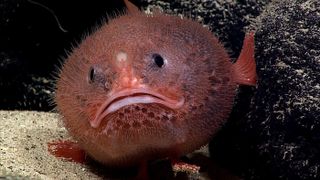Undersea Robot to Hunt for Strange Life of Deep Pacific: Watch Online

Armchair oceanographers, take note: This week, the research ship Okeanos Explorer will send a remotely operated vehicle into the depths of the Pacific Ocean, seeking out exotic sea animals like the "walking" fish called a sea toad and other curiosities. And, you can have a front-row seat.
The ROV, called Deep Discoverer, will reach depths of 3.7 miles (6,000 meters) beneath the sea's surface. Its trip is scheduled to begin Thursday (Feb. 16), and you can watch it unfold online.
This expedition, which will run through September, is part of NOAA's CAPSTONE, or Campaign to Address Pacific monument Science, Technology, and Ocean Needs. The project, in its third and final year, is aimed at collecting data from the deep ocean within marine-protected areas in the central and western Pacific Ocean, according to NOAA. The information will not only shed light on largely unexplored areas; it will also help others to make informed decisions regarding management of the protected areas and on the issue of deep-sea mining. [See Photos of the Ocean's Freakiest-Looking Fish]
"With each expedition we not only provide scientists and decision makers with the necessary data to conduct their work, but also reach new audiences who are fascinated by what we are seeing in the deep ocean," Alan Leonardi, director of NOAA's Office of Ocean Exploration and Research, said in a statement. "This public engagement improves science literacy and fosters an interest in the sciences among young people — perhaps leading to the next generation of ocean explorers."
If this expedition is anything like the others in years past, as you watch online, be prepared to see organisms you've never seen before.
"We never know exactly what we'll see," expedition manager Kelley Elliott said in the statement. "During the first two years of CAPSTONE, Okeanos Explorer expeditions discovered new species, observed known animals in new locations or exhibiting unseen behaviors, and found living animals previously only seen as lab specimens."
For instance, during an ROV dive in the Mariana Trench, east of the Mariana Islands near Guam in the western Pacific Ocean, scientists observed a stunning jellyfish, whose flying-saucer-like bell and wiry tentacles looked more "outer space" than "deep sea." The jellyfish turned out to be a new species.
Sign up for the Live Science daily newsletter now
Get the world’s most fascinating discoveries delivered straight to your inbox.
During the upcoming expedition, the ROV will explore areas around the National Marine Sanctuary of American Samoa, the Rose Atoll Marine National Monument, the Musicians Seamounts and the Pacific Remote Islands Marine National Monument, according to NOAA.
Original article on Live Science.

Jeanna served as editor-in-chief of Live Science. Previously, she was an assistant editor at Scholastic's Science World magazine. Jeanna has an English degree from Salisbury University, a master's degree in biogeochemistry and environmental sciences from the University of Maryland, and a graduate science journalism degree from New York University. She has worked as a biologist in Florida, where she monitored wetlands and did field surveys for endangered species. She also received an ocean sciences journalism fellowship from Woods Hole Oceanographic Institution.

